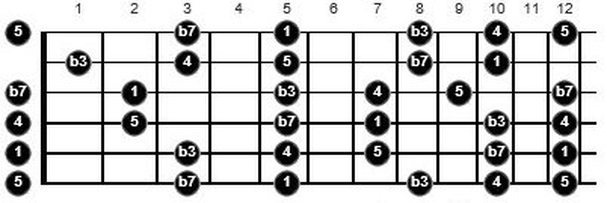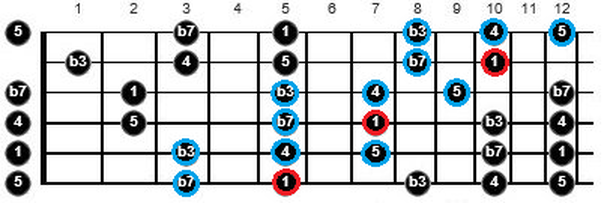You’ve probably had the ‘pleasure’ of being in a guitar shop and hearing someone noodling in A minor or E minor pentatonic while trying out a guitar, so much so that you probably recognize those scales without even looking at what the guy or gal is doing. And who can blame them? The most popular beginner route is to start soloing using the A minor pentatonic scale and the inevitable box 1, but they all end up sounding the same. In this article we looked at how to use the other four minor pentatonic boxes, but what else can you do to avoid sounding like everyone else when playing the good old minor pentatonic scale?
Here’s the trusty A minor pentatonic scale all over the neck. Box 1 probably glares out at you with the other four (mostly unused) patterns propping up box 1.

The famous five shapes are not set in stone, although their authority is rarely questioned—you get the five shapes to learn, you learn them and start wailing away over the nearest backing track. This is all well and good, but unless you’re exceptionally creative, you’re on the very well-worn path to death by sameness.
Most of the time a simple change of perspective is all that’s needed to make something as flogged to death as A minor pentatonic sound fresh and… less like A minor pentatonic.
Check out the following pattern which involves breaking the two-note-per-string rule to have the b3, 4 and 5 on the same string. Make sure your second finger plays the root note at all times to start off with, as this will stop you reverting to the boxes. Your fingering should be as follows:
Starting from the A at the 5th fret on the E string:
E string: 2
A string: 1,2,4
D string: 1,2
G string: 1,2,4
B string: 1,2
E string: 1,2,4
Come back down the position with the same fingering.

It feels a little strange at first, but it immediately gets you away from any cliché A minor pentatonic lick, and if played at speed is a great run by itself. We’re using the exact same notes as box 1 but this slight change of perspective will lead you to new ideas, and things you probably wouldn’t have thought of playing in A minor pentatonic from the 5 boxes perspective.
You can apply this method to most aspects of guitar playing. It really helps to see the bigger picture by mapping things out as we did here, and to question how things are normally done or learned; this way you can see other possibilities on the fretboard.



